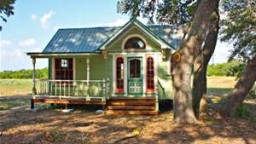Tiny houses. They’ve been a trend for a while now, and you’ve probably heard of them – maybe even seen one in person. What’s the deal, and why are so many people so interested in living in homes that boast less square footage than the average dorm room?
The size of the average American house keeps getting larger despite the fact that the average family size has decreased. Increasing from 1,780 sq. ft. in 1978 to 2,662 sq. ft. in 2013, some people feel that houses are simply too large and expensive nowadays. With student loans running rampant and wages relatively stagnant over the past few decades, living far under your means starts to make sense.
But while we’re on the subject of size, just how small does a house need to be before it reaches the very chic “tiny house” status? Wikipedia says that a house has to be under 1,000 sq. ft. before it’s considered a part of the small house movement. Some designs, such as those by the very popular small house manufacturer Tumbleweed Tiny House Company, clock in at far under that 1,000 sq. ft. threshold. The smallest by Tumbleweed, in fact, is a mere 117 sq. ft. That’s small, I don’t care who you are.
At this point you may be trying to picture how this works. Let’s say your house is the size of the average American house – roughly 2,662 sq. ft. Now take 4.4% of that. Could you do it? No, probably not. But keep in mind there’s a lot of fat to be trimmed off the average home, be it a hallway that does nothing more than give you some more wallspace for photos or a dining room that no one really ever eats in.
What would you be left with if the house were trimmed down to the bare essentials and nothing else? Tiny homes make good use of every one of their very few square feet, frequently utilizing built-in cabinets and loft areas to make up for their comparative lack of space. There’s certainly no room for clutter – and, in most cases, hardly room for many possessions – but that seems to be the way the inhabitants like it. Oh, and then there are the wheels on the bottom.
Now here’s where the story gets interesting. Yes these are small homes, and yes there are certainly some communities that specifically cater to small homes and the people that love and live them such as The Meadows in North Carolina, but on the whole people seem to be roaming around in these things. They’re almost invariably built on top of a trailer, and when you’ve got wheels on your home, it’s pretty easy to give in to temptation and park your house anywhere you want it.
Is this legal? Depends on where you park, but mostly no. It’s a good way to avoid property taxes while living in a more luxurious – and attractive – space than most RVs, and for those wanting nothing more than to live off the grid it’s perfect. Park your house in a secluded area, pop up some solar panels, and tend to your vegetable garden while you kick back and live the high life.
They’re cheap, too, with costs ranging from about $20-50k as of 2012. 68% of tiny house owners live without a mortgage. The designs themselves can be perfect fodder for Pinterest, such as this bus-turned-tiny-home, and many people report that having less house has forced them out into the world, to adventure and experience things. You know, to actually live.
Don’t get me wrong, there are certainly problems. Their awkwardly tiny size means that banks won’t finance them, and they can’t be parked in most RV parks because they’re too tall. They’re expensive to tow due to their corners in lieu of rounded edges, and, since they’re built on trailers, electricity and plumbing typically works the same as in an RV.
Last year Spur, Texas, was declared the first “tiny house friendly town”, and it seems that tiny house communities have popped up all over the country.
It’s most certainly a fad, but it’s a fad that the rest of us could learn from: do more with less, make use of the space we have, and maybe even make it outside every now and then. The part about a 117 sq. ft. living space, though, we could maybe do without. If you’d rather reserve your judgement and try it out for a night, though, you could always “test drive” a tiny house for yourself.
So what do you think? Will all the love for tiny homes blow over in a few more years, or is this an interesting and meaningful new housing movement? Let us know below in the comments!
